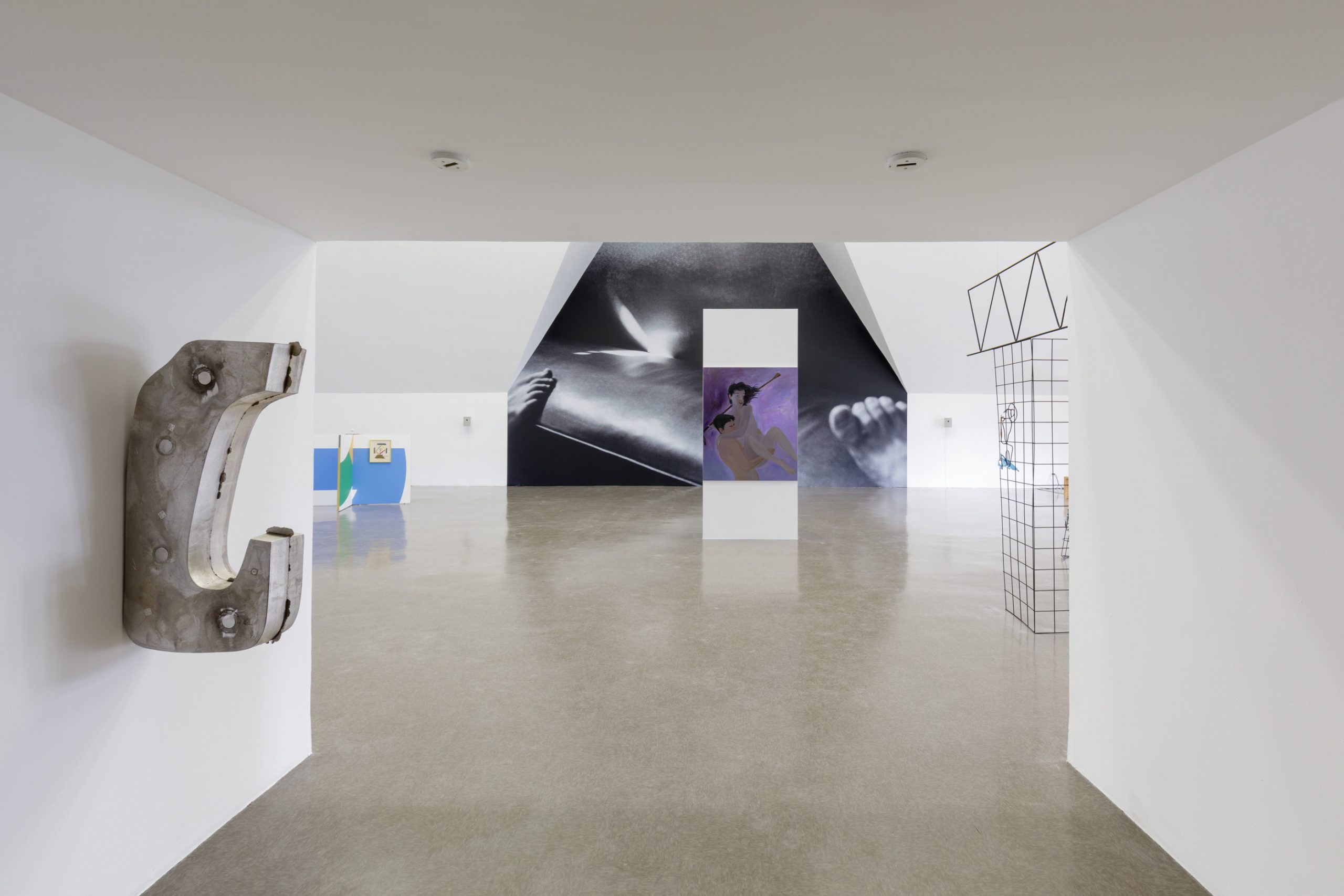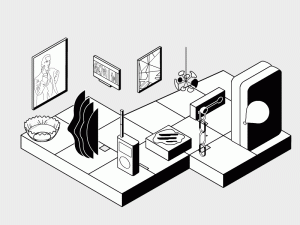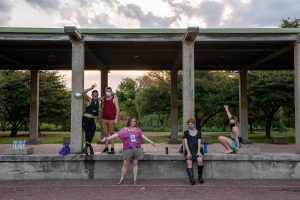Featured Image: Smashing into my heart, installation view 2021. A view looking into the galleries at The Renaissance Society. Photo by Useful Art Services.
“Wasn’t friendship its own miracle, the finding of another person who made the entire lonely world seem somehow less lonely?”
Hanya Yanagihara, A Little Life
“Being cannot be anything but being-with-one-another, circulating in the with and as the with of this singularly plural coexistence.”
Jean-Luc Nancy, Being Singular Plural
Smashing into my heart was a significant group exhibition in Chicago, the first curatorial experiment of new Renaissance Society director Myriam Ben Salah in the space. Borrowing its title from a Danez Smith poem—“i got a crush on each of your dumb faces / smashing in my heart like idiot cardinals into glass”—the show offered various queer attestations of “friendship as a way of life” (to steal from Michel Foucault). It was a fitting, if loose and abstract, theme for a moment that continues to highlight in stark relief how essential and sustaining care is, even when it is fraught or asymmetrical, for our ongoing survival. I worry the show was underviewed, and I have been disappointed to find hardly any write-ups of the show, so I am belatedly taking matters into my own hands since it had a smashing impact on my own heart.
“A vital alliance, a sharing of acts and thoughts, an exercise in freedom, friendship is not a stable bond,” Ben Salah wrote in the essential read exhibition essay Desire-In-Uneasiness, “but a vector of accountability and identification outside oneself. It is a shifting framework for interrogating how we move in the world.” We’ll borrow this as a working definition for a various field of shifting, contingent, and often vexing vectors of relation that pass under the flag of friendship, and we’ll probe what art can offer in its midst. Specifically, how can we visualize the geometries of “desire-in-uneasiness” in the space between us?
But first, I want to acknowledge the depth of the exhibition’s conceptual and literary framework, as apparent in the heady companion reading list. Not that the exhibit cannot be enjoyed in its sincerity, sensuality and physical exuberance without the footnotes—but the rigor of attention to the nuances, poetics, and political resonances of care expanded the scope of its reach.
Central to this effort was the exhibit’s inclusion of images by the late French HIV-positive writer and photographer, Hervé Guibert. Temporally, these stand apart—while the other pieces in the show are from the last ten years, his prints date from the 1980s. Despite this, they do not feel out of place: his black and white photographs, a visual throughline across the exhibition space, provide an archival backbone to the exhibit.
The inclusion of his photographs supplements the legacy of his writing that was also clearly on Ben Salah’s mind, including his novel To My Friend Who Did Not Save My Life, which suggests that art itself can be a companion (yet still let one down): “I’m beginning a new book to have a companion with whom I can talk, eat, sleep, at whose side I can dream and have nightmares, the only friend whose company I can bear at present.”
I too know the consummate desire for companionship in books. In summer and early autumn, I was making the hour-long trek on public transit to the Gerber/Hart LGBTQ Library & Archive on weekends for a reading ritual. I worked my way through volumes of out of print poetry chapbooks, art books, and novels by Audre Lorde, Judy Grahn, Essex Hemphill, Samuel Delaney, Peter Hujar, and others, scanning pages and copying out favorite lines in my notebook for hours at a time. Even though I knew I could check out the books, there was something special about visiting this physical space to read and respond to this lineage of work.
Something about this space’s history felt like a portal like I was gliding on a dance floor with queer and trans-writer heroes. This vast room was a far change from my university library where the HQ stack of gay books filled one bookcase. Lingering, also, was the presence of long-distance friends I was missing during the pandemic. I remembered a queer zine-making workshop with Stefania and Matt, now in St. Louis and Las Vegas respectively, and I also remembered linking up with Sasha, now in Atlanta, for side by side research, stopping every now and then to read out loud (in conspiratorial library voices) something giddy we had found.
This was where I read To My Friend Who Did Not Save My Life for the first time, which is probably best known for outing Michel Foucault, and which I sought out after reading Kate Zambreno’s To Write As If Already Dead, commissioned for Columbia University Press’s Rereadings series. The genius of Zambreno’s title, which subtly repurposes the “to” of Guibert’s address (“to my friend”) to an infinitive (“to write”), illustrates the complexity of the dimensions of her study of friendship and betrayals of its privacies in art, and most of all, the urgency of writing as total commitment to life, in a desperate attempt to hold these intimacies against time’s onslaught.
The first part of Zambreno’s book, before the business of close reading Guibert, veers personal: a short roman à clef about a tentative, uneasy friendship with another writer, formed through online correspondence. Somewhat in parallel to Guibert’s outing of Foucault (fictionalized as “Muzil”), this epistolary plot divulges some private details from the life of a reclusive underground Asian American queer experimental poet/novelist, “Alex Suzuki,” whose identity, while cloaked, I was able to recognize as one of my favorite authors. Tempted as I am, I won’t reveal her here—though she left a Goodreads review under her real-life heteronym (“It was a meaningful experience for me, one that I learned a lot from, and although I was caught off guard at first I do feel moved by her novelized account of this friendship in the first part of her book”). Forget art imitating life: real life comes after the fiction that chases real life, and it’s turtles all the way down.
…but how have I digressed this far? I can’t help but think of Guibert’s dig at Muzil’s (cough, cough: Foucault’s) writing on the history of sexuality in To My Friend: “Following peripheral paths from detour to detour, following supplementary paragraphs to burgeon into something more like complete books, he becomes lost…” This is not meant to be a book review, nor literary gossip, merely a back history of my own encounter with Guibert, which was, if not the main reason, at least a contributing factor for my interest in coming to see Smashing Into My Heart.
Alright, I’ll cart us back to the exhibit, with one final passage, on friendship’s frisson:
“Between fits of coughing, however, [Muzil] was eager to report on his latest escapades in the baths of San Francisco. That day I remarked to him, “Those places must be completely deserted now because of AIDS.” “Don’t be silly,” he replied, “it’s just the opposite: the baths have never been so popular, and now they’re fantastic. This danger lurking everywhere has created new complicities, new tenderness, new solidarities. Before, no one ever said a word; now we talk to one another. We all know exactly why we’re there.”
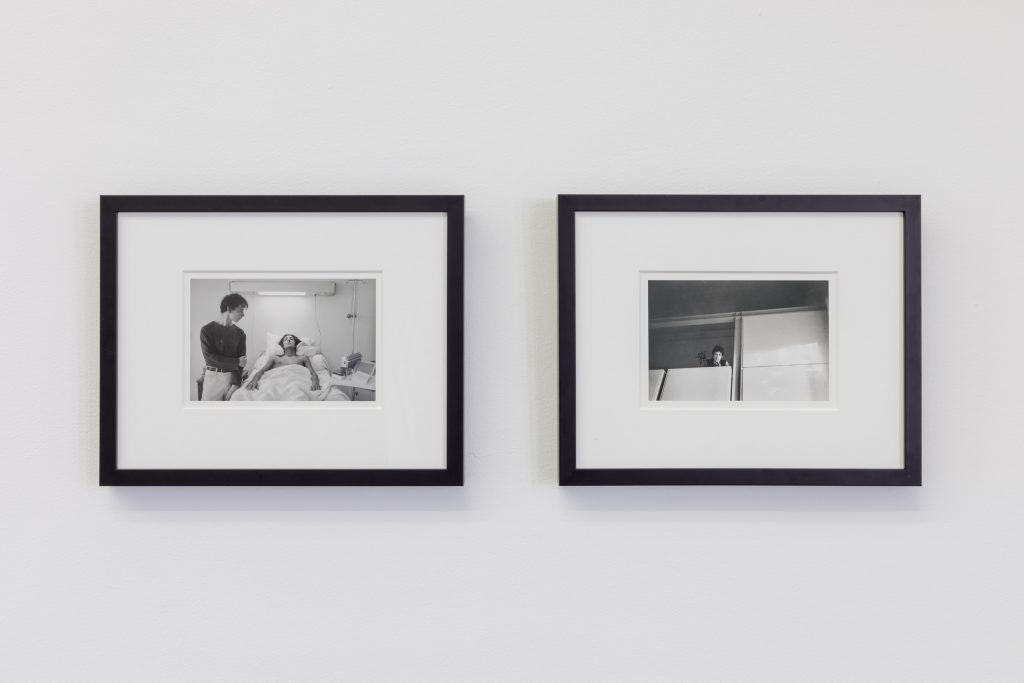
“New complicities, new tenderness, new solidarities”—living through yet another epidemic, do we know exactly why we’re here [at the museum]? Why, after over a year of six feet and masks and Zoom calls and virtual art exhibitions, we need the company of art, its visceral saturation? Can art make us feel newly complicit or tender? Solid or in solidarity, in spite of our solitudes?
Guibert’s image-making picks up where his words leave off, punctuating them with breathless moments of unspoken desire and confidences. His photograph Les Amis captures two young men in an intimate hospital bedside moment. The man in bed is shirtless, arms spread out like wings, eyes closed, seemingly at peace, though probably in considerable pain. What is the nature of that gaze from his bedside companion—adoration, concern, friendly or sexual even? “Watching is the format of friendship,” Ben Selah quotes Lily Scherlis in her essay. Via Guibert’s lens on this sitting beside, the viewer is also drawn into this quiet act of witnessing, a multiplication of its tenderness. In the early 1980s, when HIV was still being identified and people living with it were ostracized and alienated from systems of care and abandoned and left to die by homophobic governments, media, church, and even family members, support from chosen family was everything.
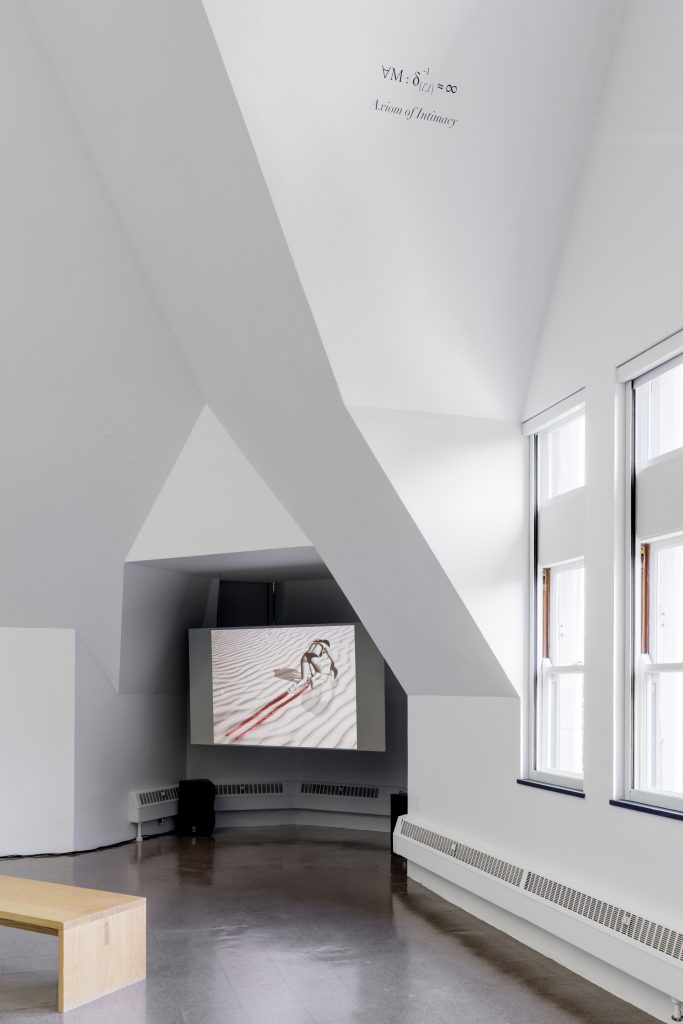
Another Guibert photograph, Deux pieds sur banquette, is blown up as a vinyl print on the back wall and feels like an altar, framed between 2-channel speakers of another artist’s sound piece and reaching to the edges of the slanted ceiling. This large scale tableaux’s hazy tenderness, its cropped close-ups on fragmented feet on a bench, two people’s toes curling towards each other from a walkable distance in the magnified gallery setting, emphasized the prepositional logic of what I have called wi(d)th, a push-pull of familiarity and distance that governed the exhibit as a whole. Paradoxically, “wi(d)th” sonically doubles as a unit of attachment and also an interval of separation. The pang of “being singular plural,” as Jean-Luc Nancy phrased it, might include an unattainable desire for the opposite of loneliness.
Is there any question more prevailing in friendship than our preoccupation with the space between us? Propinquity as a shared ground of nearness of experience is, according to social psychologists, the best predictor of our friendships and romantic affiliations. Our desires to be close and get closer to each other sustain us, but also create asymmetrical tugs of war within a dance of distance. In this sense, “smashing” is the perfect verb to set off the collision course of the exhibit.
So let’s attune to the geometries of intimacy at play throughout the exhibit. How space becomes everything. We find a literal expression of this in existential mathematician’s Laurent Derobert’s Axiom of Intimacy and Index of Proximity, formulas postulated above viewer height on the slanted roofs by the windows on antipodal sides of the room. This play on distance was also paralleled conceptually by Ceal Floyer’s erasure sound piece Me/You (Love Me Tender), which took out all the words to the Elvis Presley song Love Me Tender other than “Me” and “You” to let the hollow sonic space between these figures reverberate.
By contrast, nearness was the operative strategy of other works in the show, like Nairy Baghramian’s Mooring (hanging). Two heavy silver-cast aluminum sculptural anchors wrap around the corner of the entrance hallway, just out of sight from each other, but the magnetic field of their co-presences still palpable. Or, at the center of the room, Xinyi Cheng’s painting A Whip—a sensual and evocative figurative portrait of two light-skinned, nude, androgynous companions, one lifting the other into a bruised purple color field. Eyebrows lifted, mouth open, hair blowing in the wind: this is the ecstasy’s face, the giddiness of being carried away, transported by desire. Note the verticality in both of these works which defies gravity, emphasizing the poetics of flight inherent in how we carry each other, hold one another up.
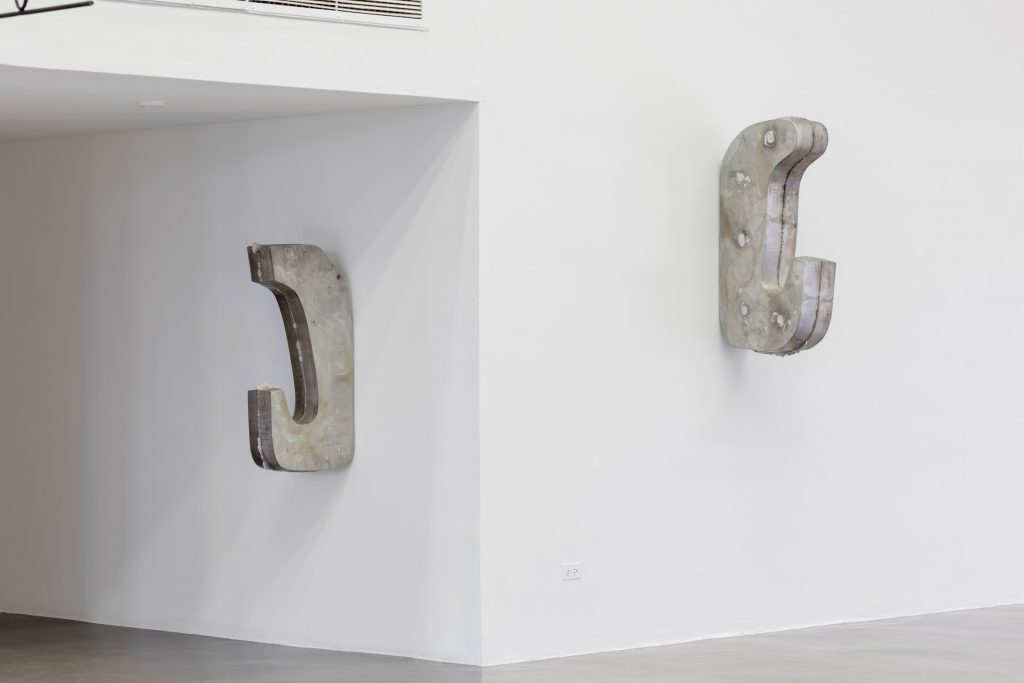
But it isn’t just the spatial play in individual works; as a whole, the show makes ingenious use of the kunsthalle’s architectural elements. The Renaissance Society occupies a large hall on the fourth floor of a campus building at the University of Chicago, with bright windows, steep roof slants, and a cave corner. These features were accentuated with care, even when that meant unusual placement. Equally impressive was the playful balance of large scale and small works, somehow both filling the space yet also making space, as if to demonstrate an ethos of sharing. Clearly, Ben Salah took pleasure as a curator in becoming familiar with the quirky physicality of her new home, especially after taking the reins amidst a quarantine season of virtual art exhibits.
Even prior to the gallery’s entrance, Ebecho Muslimova’s ebulliently corporal, cartoonish large-scale purple mural FATEBE BIG SQUEEZE AT COBB HALL, spills across the walls and floors of the university hallway, like the portal of a hug. The enthusiastic greeting left an endearing first impression, and the motif of the feet set up a satisfying symmetry with the Guibert print on the back wall.
I also want to single out Tita Cicognani’s video I Am So Full of Longing and Desire It Gushes Out of My Knees as They Scrape the Ground Upon Which I Crawl Toward You, which played on a monitor in a corner cave (the corner, as Robyn can attest, is a particularly pained site of lonely longing). It featured a bikini-clad Sims avatar crawling across deserted virtual landscapes interspersed with clips of gestures of endearment from early 2000s pop culture, all set to a spectrally slowed down version of Alice Deejay’s Better Off Alone. Festival EDM synths set an unsettling, arrhythmic pulse, and the singer’s question “Do you think you’re better off alone?” took on taunting existential proportions with each repetition, further dramatizing the crawl—Pope L’s trademark performance action transposed to internet culture. Looped every ten minutes, the post-ironic sincerity of Cicognani’s video eventually verged on the saccharine, but it illuminated how loneliness too can be a crowd, and via Cicognani’s avatar, we are all a part of this shared experience of being apart from, in all the mushy neediness that entails.
I’ll close by circling back to the Danez Smith poem. I think it’s telling that a few stanzas before the titular lines, we also get “o my many hearts” as a form of address to beloved friends. Smith invokes “my heart” as a porous and multiple instrument within the poem, as an articulation that what is mine is also what is yours. This smashing together of “my heart” and “my many hearts” is some poetic magic, a collision course that the exhibit Smashing into my heart deftly captures.
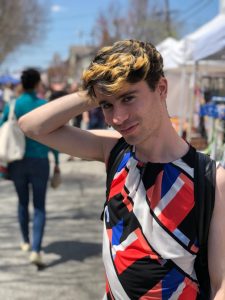
Noa/h Fields is a genderqueer poet and teaching artist. They have written for Filthy Dreams, Telekom Electronic Beats, Anomalous Press, and Scapi Magazine, among other publications. Their first poetry book WITH is out from Ghost City Press. They are fond of techno and avocados.
